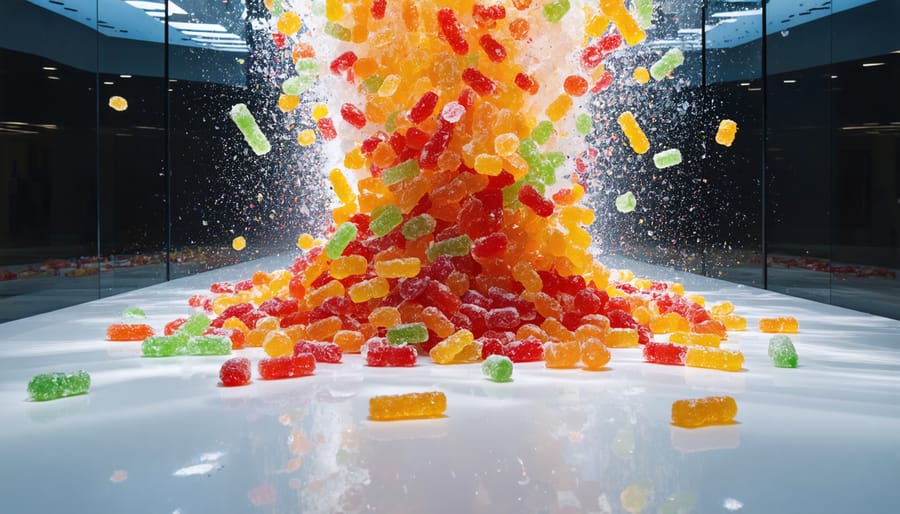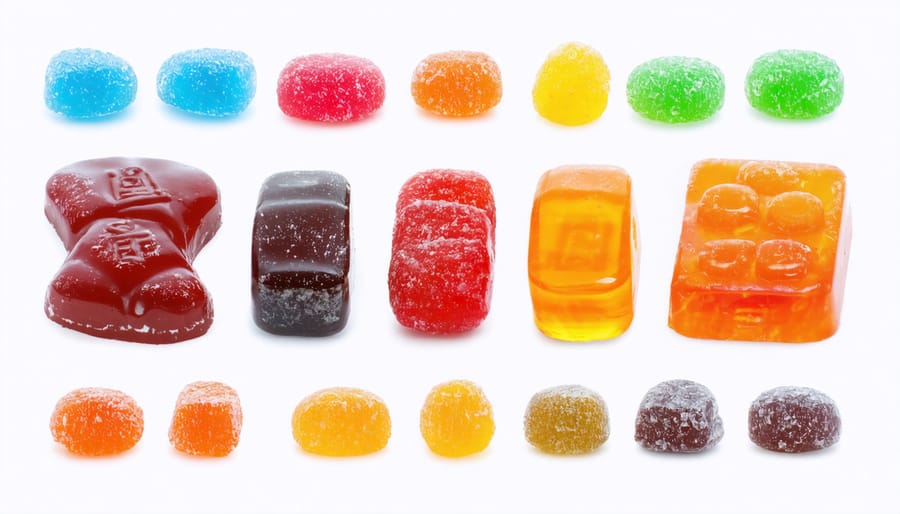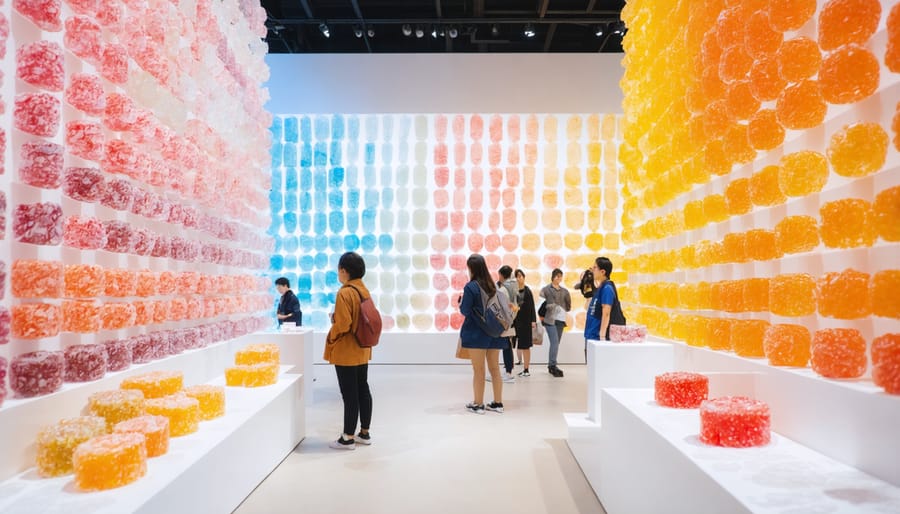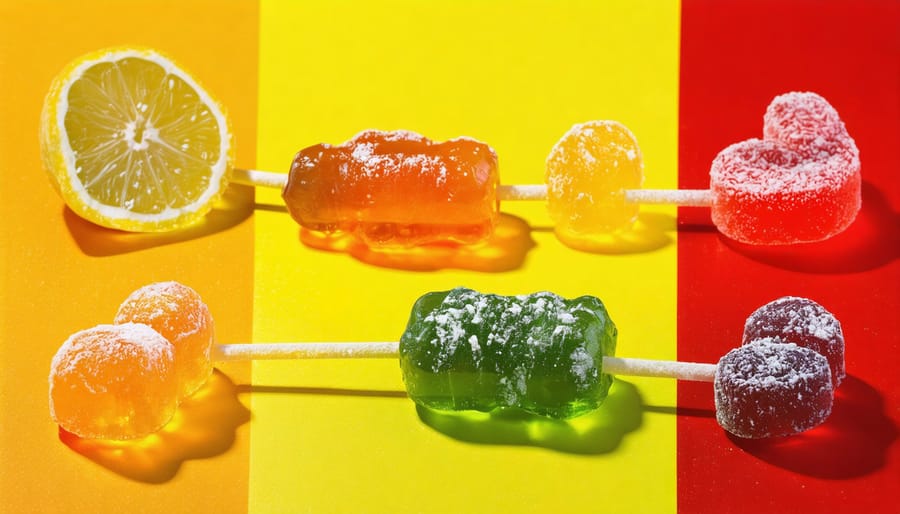
Explore the transformative power of incorporating culinary creativity with British art by utilising vibrantly coloured freeze-dried candies. Begin by exploring the innovative use of Spaceman candy in art installations to add dynamic visual and tactile dimensions. Next, examine leading artists who craft surreal landscapes and abstract compositions using these sugary elements, pushing the boundaries of traditional mediums. Investigate how these installations reflect contemporary societal themes, offering commentary on consumer culture and the ephemeral joys of indulgence. Delve into the multifaceted dialogue between art and gastronomy, where the intersection with architecture and light art propels these installations into immersive, multi-sensory experiences. Engage with the cultural impact of these installations within British culture, where they challenge perceptions and encourage a new appreciation for non-traditional art forms.

The alchemical art of freeze drying candy, an evocative blend of culinary mastery and aesthetic innovation, has found its niche in contemporary British art installations, captivating the curious minds of young adults and professionals alike. Originating from a mid-20th century scientific process designed to preserve food, freeze drying removes water from candy while retaining its vivid hues and essential flavours. The result is a delicate transformation – a tactile experience that crackles under touch and melts with surprising vibrancy on the palate.
In the context of British art, freeze dried candy emerges as an intriguing medium, marrying ephemeral tastes with visual spectacle. Artists exploit its distinctive crystalline texture and kaleidoscopic aesthetic to construct pieces that challenge and enchant audiences. These installations serve as a sensory dialogue, a bridge between the culinary world and immersive art, sparking contemplation on consumption, preservation, and modernity. The unexpected juxtaposition of familiar sweets in surreal settings compels a re-examination of the quotidian, inviting viewers to transcend the ordinary and reimagine cultural landscapes through a confectionery lens.
The sensory appeal of freeze dried candy in art installations is an enthralling amalgamation of taste, texture, and aesthetic wonder. Transforming sugary confection into a medium of art, these pieces captivate the imagination with their unconventional allure. The texture of freeze dried candy, notably light and unexpectedly crisp, defies the anticipations tied to its sugary origins. This auditory crunch becomes a playful counterpoint to its vivid visuals, echoing through the installation space and tantalising the senses. Artists deftly utilise this sensory intrigue to challenge perceptions, creating a dialogue between viewer and artwork that is as ephemeral as the candy itself.
In the atmospheric settings of British galleries, where architecture blends with creativity, these candies form surreal landscapes—a collision of the childlike whimsy and the sophisticated exploration of sensory boundaries. As installations meld the culinary with the conceptual, they invite us not only to see but to taste, to listen, and ultimately to reimagine the everyday. This intersection of art and taste is a celebration, forever questioning the lines we draw between the visceral and the visual.
Traversing the vibrant intersections of culinary whimsy and contemporary art, British artists have begun to embrace freeze-dried candy as a unique medium in their installations, leaving an indelible mark on the creative landscape. Leading the charge is Sophie Hammond, whose installation “Sugar-Preserved Dreams” captivated audiences at the Tate Modern with its intricate amalgamation of coloured confections suspended in translucent resin, a commentary on the ephemerality of consumer culture and nostalgia. Her works are a playful yet poignant critique of modernity’s endless pursuits, using sweetness as a double-edged sword.
Following Hammond’s innovative approach, Joshua Layton’s “Decay and Delight” envelops viewers at the Whitworth Gallery with a surreal garden, where freeze-dried sweets mimic vibrant flora, challenging perceptions of nature and artificiality. Layton’s work delves into the juxtaposition of beauty and decay, provoking thought about the temporality of both art and life. In these boundary-pushing installations, freeze-dried candy transcends its mundane existence, transformed into a symbol of cultural reflection and artistic rebellion—a sweet revolution within the British art scene.

In the stirring realm of British art installations, the inclusion of freeze-dried candy disrupts traditional artistic sensibilities, weaving a narrative rich with subversive dialogues and innovation. By employing such unconventional materials, artists amplify the dialogue surrounding transience and transformation, echoing the ever-evolving themes of modernity. This tactile feast, both visually arresting and texturally intriguing, challenges the perception of everyday objects, urging the spectator to reassess the mundane through a kaleidoscope of creativity.
The juxtaposition of art and confection encapsulates the essence of indulgence and ephemerality—an apt metaphor for contemporary societal dynamics. In a culture dominated by fleeting digital interactions and instant gratification, these installations provoke contemplation on permanence and decay. The playful absurdity of candy, historically trivialised, assumes a profound role in the narrative of materiality and artistic revolution, deftly balancing between delight and decay.
Incorporating elements like freeze-dried candy further bridges the gap between art and audience, rendering the installations accessible yet enigmatic. Such iterations are not merely sugar-coated fantasies but critical musings on consumerism and the saccharine veneer of modern life. By blending the whimsical with the profound, these installations position themselves as poignant yet jubilant participants in the vibrant tapestry of British cultural discourse, redefining contemporary art’s reach and resonance.

Using freeze dried candy as a medium, British artists create installations that challenge our perceptions of modern dietary habits against the backdrop of consumer-driven indulgence. This unconventional material, with its vibrant hues and curious textures, serves not merely as an aesthetic delight but as a provocative commentary on the sugar-laden allure that dominates contemporary nutrition. In these works, candy transforms into a symbol of consumption and convenience, simultaneously seducing and unsettling the viewer with its artificial luster.
Artists cleverly juxtapose this playful sweetness with a serious undercurrent—an exploration of the sugary facades often masking the hollow emptiness of a fast-food culture. The ephemeral nature of these candies echoes the fleeting gratification of our dietary choices, inviting audiences to reflect on the corporeal and ethical implications of such lifestyles. By embedding culinary elements within the artscape, these installations forge a vibrant dialogue about nourishment and the cultural palate, rendering the familiar into potent catalysts for societal introspection.
In the luminous tapestry of contemporary British art, the integration of freeze-dried candy presents a provocative intersection of sustainability and ethics. As these vibrant confections morph from mere treats to artistic media, they invite reflection on consumer culture and environmental stewardship. Art that devours itself—edible yet ephemeral—challenges the boundaries of consumption, questioning the morality of utilizing food in non-nutritive contexts amidst global hunger issues. Yet, such art also proposes an ingenious repurposing of surplus confectionery, symbolizing a cycle of creation and decay. These installations thus serve as both a celebration of innovative materiality and a critique of disposable indulgence, crafting narratives that resonate within the cultural and ethical landscape.
Freeze dried candy has captured the imagination of British art audiences, challenging traditional perceptions of both culinary elements and visual aesthetics. Critics and gallery-goers are drawn to the playful yet profound use of these vibrant sweets, which juxtapose the ephemeral indulgence of candy with the permanence of artistic creation. This unexpected fusion often prompts a blend of nostalgia and curiosity, as spectators engage with works that straddle the line between eye candy and substantial critique. Exhibitions featuring these edible sculptures invite deeper reflection on consumption, excess, and the disposable nature of contemporary society. Critics have noted how these tactile and visually arresting installations evoke a sense of wonder, bridging art and food in a dialogue that is both whimsical and incisive. Such inventive expressions are redefining the boundaries of British art, leaving a lasting impression on an audience eager for innovation.
Harnessing the whimsical charm of freeze dried candy in artistic spaces opens portals to a future replete with sensory experiences. In the UK, where art has always thrived on innovation, these sweet sculptures guide us toward a playful yet poignant cultural metamorphosis. By juxtaposing candy’s ephemeral nature with enduring artistic themes, creators invite spectators to savour contrasts—a metaphorical dance between the transient and the eternal. As light art brilliantly echoes off crystallised confections, new forms emerge, redefining our perceptions of art and food alike. These creations become more than just visual treats; they provoke dialogue about sustainability, consumerism, and the meaning of art in a fast-paced world. With their vibrant hues and unexpected textures, these installations also challenge traditional boundaries, inspiring a newfound appreciation for the artistic potential of everyday items.
In the intriguing landscape of British art installations, where the boundaries of culinary delights and visual storytelling blur, freeze-dried candy emerges as an unexpected muse—a vibrant metaphor in the narrative of modern culture. This fusion transcends simple novelty, revealing layers of significance that speak to the transient nature of pleasure, the nostalgia of childhood, and the delight of sensory immersion. In exhibitions where light, architecture, and sweet confections intertwine, the familiar becomes surreal, engaging the viewer in a reimagined sensory experience.
Much like the innovative spirit embedded in British heritage, these installations beckon an exploration beyond the superficial sweetness of candy; they challenge the observer to recognise the intricate interplay of form, flavour, and perception. As viewers traverse spaces where candy hangs suspended in translucent frames or spills across mirrored floors in opulent neon hues, they are invited to ponder the intersection of consumption and creation, questioning what is ephemeral and what lingers.
In this dynamic artistic expression, the freeze-dried candy installations reflect a burgeoning dialogue in British culture, one that wistfully harks back to earlier memories while boldly venturing into the avant-garde. Herein lies their captivating charm—a rich tapestry of visual enchantment that resonates with a culture eager to celebrate the eclectic and embrace the unexpected. As the tableau of modern British art continues to evolve, these delectable installations poignantly underscore an era where culinary art waltzes seamlessly into the world of visual spectacle, enriching both spheres with imaginative aplomb.